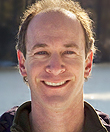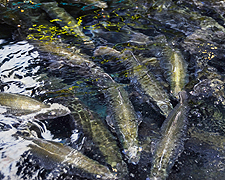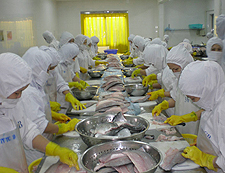Located on the Connecticut River, more than 80 miles from the Atlantic Ocean, Turners Falls, Massachusetts is an unlikely setting to rear a seagoing fish. But that is precisely what Josh Goldman, co-founder and CEO of Australis Aquaculture, is doing, using some of the most sustainable aquaculture techniques in existence today.
In its Massachusetts location, Goldman’s company annually raises about 1.2 million barramundi, an Australian fish that spawns in saltwater, lives much of its life in freshwater, and is uniquely suited to fish farming. But it’s the way that Australis raises its fish that has won it acclaim — growing the barramundi in low-density concentrations in indoor fish pens, continually recycling the water and collecting virtually all of the fishes’ waste for fertilizer, and producing a moderately priced, white-fleshed fish sold in many U.S. grocery chains and higher-end restaurants.
 Josh Goldman
Josh Goldman
In an interview with Yale Environment 360, Goldman discusses the technology behind his aquaculture operations in the U.S. and Vietnam and the challenges that global aquaculture must meet in the coming decades if it hopes to sustainably produce the majority of the world’s seafood. “Market-based initiatives can have a tremendous positive impact,” says Goldman, “and the combination of the right species and the right farming methodology will allow aquaculture to really be a very ecologically efficient part of the global food system.”
Yale Environment 360: I understand this all started with a little fish farming operation in a college dormitory, is that true?
Josh Goldman: True. The original development took place at Hampshire College [in Massachusetts] back in the early 1980s. A group of students who were protesting the construction of the Seabrook nuclear reactor at that point were asked by one of the professors, “We know what you’re against, but what are you for?” From that question came the construction of an on-campus, student-built solar green house. I moved in there the next year. We installed some fish tanks and began the journey of learning to grow fish in enclosed systems — what is today called closed-containment aquaculture.
e360: And what fish were you growing at that point?
Goldman: Tilapia.
e360: And how did you learn about closed-containment systems? You were a college student back then, and I don’t think they were widely talked about.
Goldman: Well, there was a research institute on Cape Cod called New Alchemy Institute. And New Alchemy was founded by two marine biologists who did a lot of pioneering work in year-round food production for New England. And one of their concepts was the idea of what they called the bioshelter, which was one of the early ideas that food production systems needed to mimic ecosystems and deliberately link waste products from one process to input new products. So we started to learn about and copy what they were doing, and then began to make our own innovations.
e360: And did you actually commercially produce tilapia?
Goldman: We first produced it for the food co-op and spring parties, that kind of thing, in integration with hydroponic vegetables and other vegetables.
e360: And what led you from that to the creation of Australis?
View photos
Goldman: I began by founding a company called Bioshelters, with another New Hampshire college student, and we began to commercially produce tilapia in 1986. After about a year, I formed another company that was intended to take the closed-containment technology and apply it to more challenging species. So we began to grow striped bass, which is a native fish that had been subjected to really severe overfishing at that point, as well as pollution problems.
e360: And how did that go, from an economic and environmental point of view?
Goldman: It was a tough business economically, in part because the striped bass were not inclined to spawn on a year-round basis and our system required a year-round input of fingerlings. Ultimately we weren’t really that successful at it… So we began to look much more broadly around the world at various types of fish to see whether there were species that really had great production characteristics and might fundamentally begin to answer some of the questions around sustainability that were being raised in aquaculture.
e360: When you looked at the rapid expansion of Atlantic salmon farming, what was going through your mind as you were conducting the search for the perfect farmed fish?
Goldman: From a business standpoint, it showed that with the right species you could really be successful in building consumer interest and demand. But with my environmental hat on, I was pretty convinced that they were going to run into resistance at a certain point on the use of resources in the [open] waters where these farms were located.
e360: So how did you settle on the barramundi and also on the understanding that it could be well-suited for a closed containment, fresh water system?
Goldman: One day I got a call from some friends in New York who wanted to introduce me to an Australian entrepreneur named Stewart Graham, who was pretty convinced that the barramundi had a much larger role to play in the world of aquaculture. So I met him, and he asked me to help him figure out how to get the barramundi into the U.S.
e360: What convinced you from both an economic and ecological point of view that the barramundi could work?
There’s almost no waste in the water leaving the facility.”
Goldman: Well the thing that was really interesting to me was that it reproduced on a year-round basis, which solved the problem we had with the striped bass. The fact that it would go into billabongs [small, seasonally dry lakes] — where it was subject to very hot and low-oxygen water — and that it had evolved this massive gill meant it was probably going to be pretty suitable to the conditions on a farm. And then when I tasted it, it really sealed the deal. I went over to Australia and I was exposed to this absolutely delicious piece of fish. I felt that we had something that fit a critical piece of the market, which is we needed a high-quality white fish to replace the bass, the cod, the higher-end fish. We had tilapia aquaculture and catfish aquaculture, but we didn’t have something that could supplant these high-value fish that people were still going out and capturing with abandon.
e360: The barramundi spawns at sea and migrates into freshwater? Is that correct?
Goldman: Exactly. So two things are important about that. One is in the freshwater environment it’s monsoonal, so the water flow often stops during the dry season and the water’s really hot and low oxygen. So the fish evolves to withstand those conditions. And there are not a lot of fatty acids, not a lot of the Omega 3’s in that environment. So the fish has developed a strong ability to manufacture those itself, so when it goes back out to sea, there are fish oils in the eggs for its babies.
e360: Can you briefly describe how this close-containment system works?
Goldman: The way our plant works is basically that there are a series of five different rooms, and in each room there is a series of tanks that get considerably larger to match the growth of the fish. And each tank or group of tanks is linked to a filtration system that utilizes a combination of physical filtration, as well as biological filtration, to remove the dissolved metabolites from the fish. The fish excrete ammonia into the water and the bacteria basically take that and turn it into a non-toxic form and ultimately bacteria put it back into nitrogen gas in the environment. It utilizes very little water and the waste products are recovered, so there’s almost no waste in the water leaving the facility.
e360: And the waste basically falls to the bottom of the tanks. How do you recover that?
Goldman: The tanks have a lot of flow through them, and first the waste is screened out and then it goes through a thickening system ultimately to be stored, much like a dairy farm. And then farmers come take it and put it onto the land.
e360: And I’ve read some statistic about how little waste you actually wind up with.
View photos
Goldman: It’s in the order of 15 to 20 pounds a day that leaves the farm.
e360: And how many fish do you produce annually there?
Goldman: About 1.2 million fish, which is about 2 million pounds of fish.
e360: How is the amount of waste so small? It seems like a staggeringly low figure.
Goldman: Well that’s the waste that’s leaving in the wastewater, there’s obviously more waste that’s going out into the farmer’s fields.
e360: How many tons of waste do you collect?
Goldman: Probably about a quarter million gallons a year, something like that. There are local haulers that service the farming community, and they come in here with a few trucks. It just takes a couple of days in the fall and a couple in the spring, and all that goes out into the fields.
e360: And you’ve got no problem getting rid of it? There’s enough demand up there?
Goldman: We don’t. There’s a lot of demand for it because it’s got no weed seeds, and the farmers love it.
e360: How many people do you employ at your facility in Massachusetts?
Goldman: About 50 people on site.
e360: And basically these fish in the wild are carnivorous, or do they also eat vegetable matter?
Goldman: They would eat pretty diverse range of foods, but all basically fish, crabs, crayfish, that sort of thing.
e360: And what do you put in their feed?
Goldman: They’re eating a diet that’s about 80 percent vegetable-based — which means soy, wheat, corn, canola — and 20 percent fishmeal and fish oil. And a third of that fishmeal is by-product meal, so it comes from trimmings from other fish.
e360: And how did you figure out that you could feed a carnivorous fish 80 percent vegetable-based food pellets? That seems an interesting transition I would think even the salmon people might want to know about.
Goldman: They’re kind of heading in the same direction. Because of what’s happening with [overfishing], everyone has to get there. We were just more aggressive about it because of what we stand for, but also a lot of research here and in Australia to do targeted substitution.
e360: And it doesn’t affect the flavor?
Goldman: It doesn’t. We use more fishmeal right at the end to influence the flavor and to help boost the Omega content. But mainly the flavor is derived by the water quality more than their diet.
e360: I understand that you’ve got more demand than you can satisfy in the U.S.
“To grow 2 million pounds of fish we need to recirculate 60 million gallons of water a day.”
Goldman: It’s sort of ebbs and flows, but right now that’s true. Our U.S. fish is all fresh, and we have our facility in Vietnam, as well, producing predominantly frozen fish. In Vietnam, we needed to find a way to meet a broader need in the market and [compete] with everything else in a conventional retail environment. So we took the technology and we’re using the closed containment for a third of the lifecycle and then we’re going to sea cages for the final two thirds.
e360: It’s more economical to use open cages than closed-containment systems?
Goldman: Yes, much, much more economical.
e360: Because of energy costs, primarily?
Goldman: Energy costs, and to a greater extent the capital costs and the labor costs. Closed containment requires a lot of people to operate because in this facility to grow 2 million pounds of fish we need to recirculate 60 million gallons a day, and that requires mechanical people, chemistry people, a lot of physical movement of the fish to optimize the fit between the size of the fish and the size of the tank. There’s much more that goes into it. So what we’ve endeavored to do [in Vietnam] is to utilize rotational fallowing and other strategies to address all of the key considerations from an environmental standpoint. We have a 2 to 1 fallowing regime, so we grow for one cycle and fallow for two.
e360: If open sea cages are much more economical, how is it that closed containment, particularly onshore, is going to have a future?
Goldman: It will have a future for some kinds of specialty markets for sure. And then the other future, I think, is working in concert with open systems in smarter ways. So for example, in Chile they were growing a lot of salmon in lakes, which was deleterious to the lakes because it created a lot of disease problems. Increasingly they are moving toward closed containment for the first year of the production cycle. The big issue is not so much the pollution, because if the farm is well sited and it’s rotationally fallowed, I think the data shows that’s a very manageable issue with the right species and the right management regime. I think the biggest issue is the fishmeal and fish oil because we’re going to need so much more to come from fish farms with a fixed base of fishmeal and fish oil. And so I think the real driver is species that can utilize smaller quantities of those precious ingredients.
e360: And barramundi compared to Atlantic salmon or bluefin tuna has got that advantage?
Goldman: It does, for sure.
e360: What about disease as a limiter of aquaculture? Because between sea lice and infectious salmon anemia [ISA], Atlantic salmon farming has had tremendous problems with disease. How do you prevent that from occurring at your barramundi operations?
“In the next 20 years, all the growth in seafood is going to come from farm supply.”
Goldman: Well, to some extent rational development and not getting too big in one location is fundamentally protective. Having vaccination programs, fallowing — all those are important. I think part of why ISA was so damaging in Chile is that the farms were too crowded and there weren’t enough protective regimes in moving fish from different hatcheries. Aquaculture is much more clearly happening in a commons and managing that commons in a smart way is really critical.
e360: Compare the density of your fish to the density of fish in a salmon aquaculture operation?
Goldman: We would generally run at about one third the density within the cage. A typical salmon farm would have about 30 kilos of fish per cubic meter, and we run at about 10. I think it’s a very precautionary approach.
e360: Are both of your operations profitable?
Goldman: We’re a private company so we don’t really talk about our financials, but we’re at about 3,000 retail stores. Safeway, Stop N’ Shop, Whole Foods, Albertsons.
e360: And what would it cost me, say, for frozen fillets per pound?
Goldman: Around $9.99. So we’re trying to be in that middle price group.
e360: Let me ask you about your larger vision of aquaulture. How do you go from your operation, which is relatively small, and scale that up to have a global impact on making aquaulture more sustainable?
Goldman: Our aspirations are that barramundi become a mainstream species, and in doing so play a real role in educating consumers about making informed, smart, seafood choices. I believe that market-based initiatives can have a tremendous positive impact and that the combination of the right species and the right farming methodology will allow aquaculture to really be a very ecologically efficient and healthful part of the global food system.
e360: Do you think Atlantic salmon can be sustainably farmed?
Goldman: I do. I think if you look at the salmon industry, it’s making a lot of progress, as well, in terms of these core issues.
e360: Globally, what percentage of the seafood market is aquaculture-produced?
Goldman: It’s about half and half.
e360: And where do you see it in about 30 years?
Goldman: Probably 70 percent aquaculture. Even in about 20 years, because all the growth is going to come from farm supply.
e360: And do you think in developing countries like China and Southeast Asia that these sustainable models can really take hold?
Goldman: I think eventually they will because as these countries grow, middle class consumers are going to have very much the same interests and concerns that we have. I don’t think it’s going to happen instantly, but I think with economic success comes a set of considerations that are going to drive all of these markets toward more sustainable models.